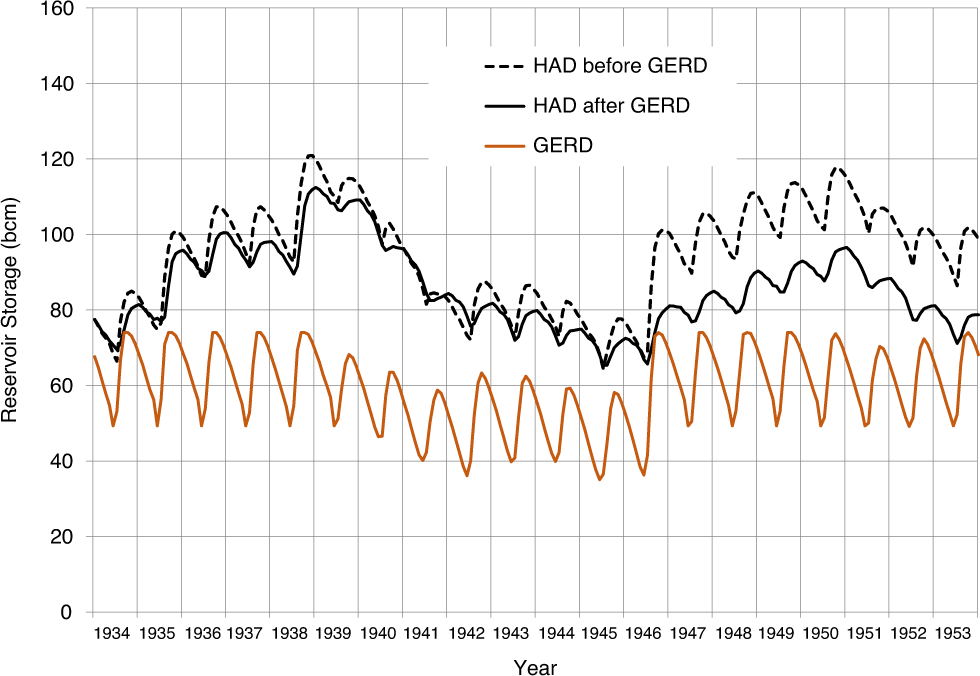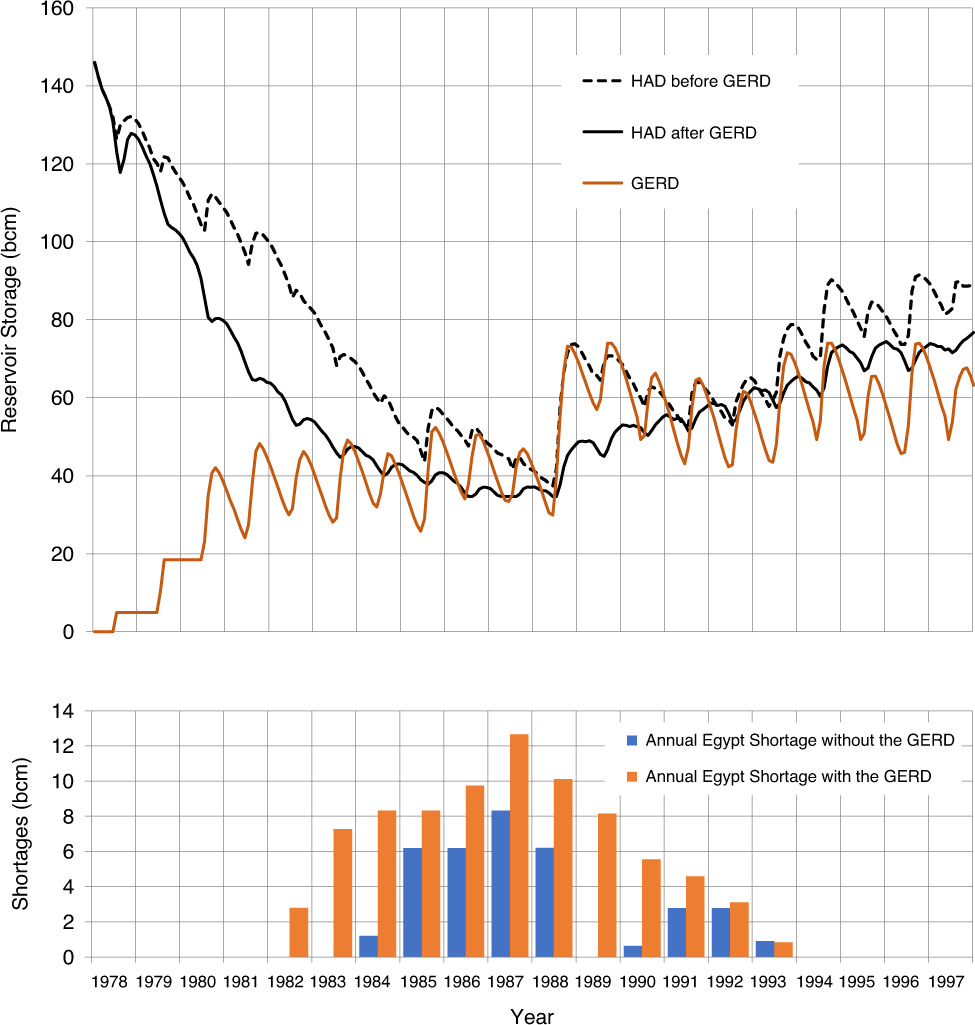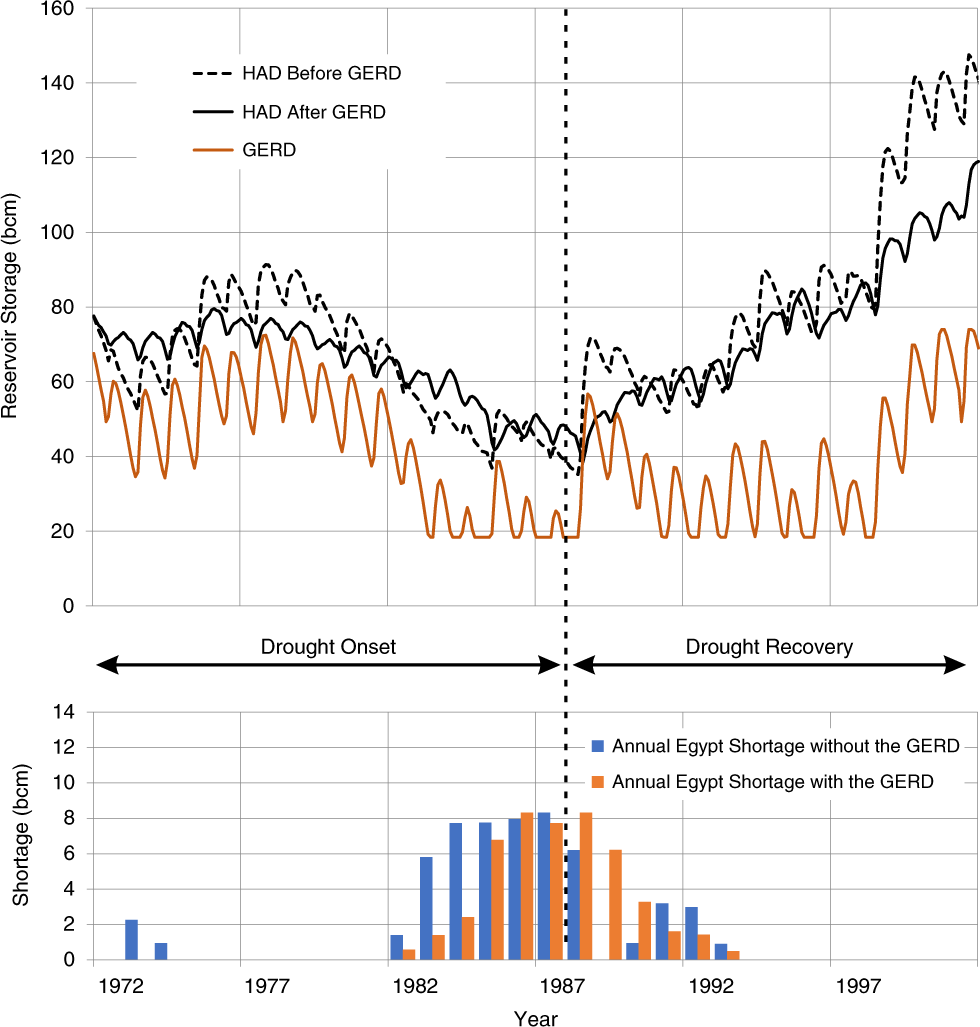Grand Ethiopian Renaissance Dam is being filled
Sentinel-1 CSAR IW acquired on 06 January 2015 at 03:32:48 UTC
...
Sentinel-1 CSAR IW acquired on 30 November 2020 at 03:25:20 UTC
Sentinel-2 MSI acquired on 30 November 2020 at 08:03:09 UTC
...
Sentinel-1 CSAR IW acquired on 30 November 2020 at 03:25:20 UTC
Sentinel-2 MSI acquired on 30 November 2020 at 08:03:09 UTC
Keyword(s): Dam, hydroelectricity, renewable energy, green energies, food security, hydrology, agriculture, climate change, global warming, land, infrastructure, alluvium, sediments, Ethiopia, Sudan.
Ethiopia has begun filling the Grand Ethiopian Renaissance Dam since July 2020. This project, the largest dam on the Blue Nile, has been a source of tensions for a long time.
On 16 October 2020, Kevin G. Wheeler published the article Understanding and managing new risks on the Nile with the Grand Ethiopian Renaissance Dam in Nature where the impact of the dam is modelled. It reminds: "The flow of the Blue Nile varies considerably over its yearly cycle and is the main contribution to the large natural variation of the Nile flow. During the dry season the natural discharge of the Blue Nile can be as low as 113 m3/s, although upstream dams regulate the flow of the river. During the wet season the peak flow of the Blue Nile often exceeds 5 663 m3/s in late August (a difference of a factor of 50). Before the placement of dams on the river the yearly discharge varied by a factor of 15 at Aswan. Peak flows of over 8 212 m3/s occurred during late August and early September, and minimum flows of about 552 m3/s occurred during late April and early May."
In the U.S. Congress funded Voice of America, Ashenafi Abedje recalls the context that prevailed before this dam project: "A 1959 treaty between Egypt and Sudan apportioned nearly 90 percent of this resource to the two downstream countries -- 55.5 billion cubic meters to Egypt, and 18.5 billion cubic meters to Sudan. The treaty did not include the upstream countries, including Ethiopia, which contributes 85 percent of the river's water. Egypt has veto power based on a provision carried over from an agreement it signed with Britain in 1929."
Since the Blue Nile is a highly seasonal river, the dam would reduce flooding downstream of the dam, including on the 15 km stretch within Ethiopia. On the one hand, the reduction of flooding is beneficial since it protects settlements from flood damage. On the other hand, it can be harmful if flood recession agriculture is practiced in the river valley downstream of the dam since it deprives fields from being watered. However, the next water regulating dam in Sudan, the Roseires Dam, sits only a few dozens of kilometers downstream.
However, hydropower accounts for less than 12 per cent of total electricity production in Egypt in 2010 (14 out of 121 billion kWh), so that a temporary reduction of 25 per cent in hydropower production translates into an overall temporary reduction in Egyptian electricity production of less than 3 per cent. The Grand Ethiopian Renaissance Dam could also lead to a permanent lowering of the water level in Lake Nasser if floods are stored instead in Ethiopia. This would reduce the current evaporation of more than 10 billion cubic meters per year, but it would also reduce the ability of the Aswan High Dam to produce hydropower to the tune of a 100 MW loss of generating capacity for a 3 m reduction of the water level.


Renaissance Dam site
Filling the reservoir began in July 2020. It will take between 5 and 15 years to fill with water, depending on hydrologic conditions during the filling period and agreements reached between Ethiopia, Sudan, and Egypt. But Egypt and Ethiopia have a hard time finding middle ground.
Declan Walsh illustrates this in an article published in February 2020 in the New-York time, quoting Prime Minister Abiy Ahmed of Ethiopia : "'No force could prevent' Ethiopia from completing the dam, he told Ethiopian lawmakers in October, less than two weeks after winning the Nobel Peace Prize for resolving his country’s long conflict with Eritrea. If it came to it, Mr. Abiy added, he would get 'millions readied' for war with Egypt". On the other side, on 3 June 2013, while discussing the International Panel of Experts report with President Mohammad Morsi, Egyptian political leaders suggested methods to destroy the dam, including support for anti-government rebels.
"While the two nations spar over the dam, hydrologists say the most pressing threat facing the Nile stems from population growth and climate change. Egypt’s population increases by one million people every six months — a soaring rate that the United Nations predicts will lead to water shortages by 2025."
The Qatari paper Al Jazeera reported that the United States pressure Ethiopia to reach an agreement: "Ethiopia, Sudan and Egypt have been locked in a bitter dispute over the filling and operation of the Grand Ethiopian Renaissance Dam, which remains unresolved although the reservoir behind the dam began filling in July. The United States has suspended a portion of its financial aid to Ethiopia over the lack of progress in talks with Egypt and Sudan about a massive dam Addis Ababa is constructing on the Blue Nile River."
"
The US move came after the three countries failed on Friday to reach an agreement on the management of the dam following 10 days of negotiations. The State Department said commencing the filling of the reservoir before necessary safety measures were implemented 'created serious risks for the populations of the downstream countries', according to AFP news agency. It added that by continuing to fill the dam, Ethiopia was undermining confidence in the negotiations."
Nature article finds out: "Once the GERD Reservoir is full, in a sequence of years of average or above average Nile flows (Era 2), Egypt is unlikely to need to reduce water releases from the HAD, provided that upstream irrigation withdrawals have not significantly increased. However, the HAD Reservoir will usually operate at lower levels than at present. Sudan will benefit from steadier Nile flows, including increased summer flows and reduced floods and sedimentation. Ethiopia will benefit from the generation of 16 TWh per year of hydropower."




Left: GERD filling effects beginning with a historically wet 10-year sequence; right: New normal conditions with the GERD under a historically average 20-year sequence - Source: Kevin G. Wheeler, Understanding and managing new risks on the Nile with the Grand Ethiopian Renaissance Dam, Nature.
"However, a severe multi-year drought (Era 3) is inevitable at some point in the future. This will be a critical event in terms of managing water risks in the Eastern Nile. In advance of such a drought, a comprehensive basin-wide management plan needs to be agreed upon, including a management policy for the Grand Ethiopian Renaissance Dam (GERD). Such agreements should specify how the reduced flow of the Nile will be shared when storage is depleted in both reservoirs, and will need to balance power generation and consumptive use. At least as challenging will be the issue of how quickly and in what sequence the High Aswan Dam (HAD) and GERD Reservoirs should be refilled. To maintain confidence that proper planning has taken place, coordinated communications with the media and public in all riparian countries will be important."




Right: GERD filling effects during a historically dry 10-year sequence followed by a recovery period; left: Entering drought conditions from new normal operations under a historically dry 20-year sequence - Source: Kevin G. Wheeler, Understanding and managing new risks on the Nile with the Grand Ethiopian Renaissance Dam, Nature
















